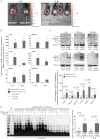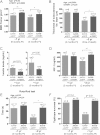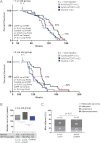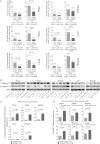Telomerase gene therapy in adult and old mice delays aging and increases longevity without increasing cancer
- PMID: 22585399
- PMCID: PMC3494070
- DOI: 10.1002/emmm.201200245
Telomerase gene therapy in adult and old mice delays aging and increases longevity without increasing cancer
Abstract
A major goal in aging research is to improve health during aging. In the case of mice, genetic manipulations that shorten or lengthen telomeres result, respectively, in decreased or increased longevity. Based on this, we have tested the effects of a telomerase gene therapy in adult (1 year of age) and old (2 years of age) mice. Treatment of 1- and 2-year old mice with an adeno associated virus (AAV) of wide tropism expressing mouse TERT had remarkable beneficial effects on health and fitness, including insulin sensitivity, osteoporosis, neuromuscular coordination and several molecular biomarkers of aging. Importantly, telomerase-treated mice did not develop more cancer than their control littermates, suggesting that the known tumorigenic activity of telomerase is severely decreased when expressed in adult or old organisms using AAV vectors. Finally, telomerase-treated mice, both at 1-year and at 2-year of age, had an increase in median lifespan of 24 and 13%, respectively. These beneficial effects were not observed with a catalytically inactive TERT, demonstrating that they require telomerase activity. Together, these results constitute a proof-of-principle of a role of TERT in delaying physiological aging and extending longevity in normal mice through a telomerase-based treatment, and demonstrate the feasibility of anti-aging gene therapy.
Copyright © 2012 EMBO Molecular Medicine.
Figures

Direct GFP fluorescence in shaved back skin of mice treated with the indicated vectors.
Dark grey bars: fold change in mean ± SEM mTERT mRNA levels in AAV9-mTERT treated mice compared to AAV9-eGFP controls; light grey bars represent mean ± SEM after setting to 1 the control mice. mTERT mRNA values are normalized to actin. At least 5 male mice per group were used. Student's t-test was used for statistical analysis.
TERT Western blots of tissue whole extracts from the 1 year-old group. Top, representative Western blot. Bottom, quantification of mTERT protein from 3 to 6 male mice. Values are normalized to actin. Student's t-test was used for statistical analysis. Data are given as mean ± SD. Molecular weight markers are shown. Controls for TERT antibody are shown in Supporting Information Fig S2.
Telomerase activity (measured through TRAP assay) in several tissues from either AAV9-eGFP or AAV9-mTERT injected mice.

Femur bone mineral density (BMD femur) at the indicated times post-treatment with the indicated vectors. Two-way ANOVA was used for statistical analysis demonstrating that both mTERT (p = 0.0002) and age (p = 0.03) contribute significantly to the differences observed. Data are given as mean ± SEM (*p < 0.05; **p < 0.01).
Thickness of the subcutaneous fat layer at the indicated time or at the time of death (in tissues fixed immediately post-mortem – see Materials and Methods Section) in AAV9-mTERT and AAV9-eGFP treated mice. Two-way ANOVA was used for statistical analysis demonstrating a significant effect of mTERT treatment (p = 0.04) and age (p < 0.0001). Data are given as mean ± SEM (*p < 0.05).
Insulin levels at the indicated times post-treatment with the vectors after mice were fasted for at least 8 h. Age-matched female mice were used. Data are given as mean ± SEM. Student's t-test was used for statistical analysis.
IGF-1 levels at the indicated times post-treatment with the vectors. Two-way ANOVA was used for statistical analysis demonstrating a significant interaction between mTERT and age (p < 0.05). Data are given as mean ± SEM (**p < 0.01).
Coordination and balance using a Rota-Rod wheel. Three trials were measured per mice. Two-way ANOVA was used for statistical analysis demonstrating that both mTERT (p = 0.01) and age (p = 0.01) contribute significantly to the differences observed. Data are given as mean ± SEM (*p < 0.05).
Neuromuscular coordination using the tightrope test at the indicated times post-treatment with the indicated vectors. Fischer's exact test was used for statistical analysis.

Kaplan–Meier survival curves of the indicated mouse cohorts (50% males and 50% females). Alive mice are plotted as a vertical line. The Log rank test was used for statistical analysis.
Average and 90th percentile lifespan of 2 year-old mice treated with AAV9-mTERT or AAV9-eGFP vectors. One-way ANOVA was used for statistical analysis (*p < 0.05; **p < 0.01). The floating bars represent the minimum-to-maximum age of death and the middle bar corresponds to the mean.
Percentage of mice with the indicated tumours at their time of death.

Percentage of short telomeres (percentage of telomeres presenting an intensity below 50% of the mean intensity of the corresponding control [AAV9-eGFP 1 year old]) 1 month post-treatment with the indicated vectors. Data are given as mean ± SEM. Student's t-test was used for statistical analysis. At least three independent mice were used per condition.
Representative Western blots of tissue whole extracts of 2 year-old male mice treated either vector, 1 month post-treatment.
Quantification of active β-catenin levels after correcting for β-catenin total levels and actin. Data are mean intensity ± SD. Student's t-test was used for statistical analysis.
Quantification of cyclinD1-positive cells with respect to total cells scored in tissues from mice treated with the indicated vectors, 1 month post-treatment. (brain – cerebral cortex [7 × 105 cells scored per mouse]; heart – myocytes from myocardium [5 × 105 cells scored per mouse]; kidney – medulla [2 × 106 cells scored per mouse]; liver – [2 × 106 cells scored per mouse]; muscle – muscle fibers [4 × 105 cells scored per mouse]; lung – [8 × 105 cells scored per mouse]). Student's t-test was used for statistical assessments.

Scheme of mTERT-wt and mTERT-DN, a catalytically inactive form of telomerase previously generated and described by us (see Materials and Methods Section).
Fold change in mTERT mRNA levels in AAV9-mTERT or AAV9-mTERT-DN treated mice compared to age-matched AAV9-eGFP controls. Values are normalized for actin and are represented as the change in mean ± SEM relative to samples of age-matched AAV9-eGFP mice (set to 1). Student's t-test was used for statistical analysis.
mRNA levels of Wnt target gene CyclinD1 in the liver of mice treated with AAV9-eGFP, AAV9-mTERT or AAV9-mTERT-DN vectors. Values are normalized for actin and are represented as the change in mean ± SEM relative to samples of age-matched AAV9-eGFP mice (set to 1). Student's t-test was used for statistical analysis (*p < 0.05; **p < 0.01).
Expression of p16 mRNA in the liver of mice treated with AAV9-eGFP, AAV9-mTERT or AAV9-mTERT-DN vectors. Data was normalized for actin and are represented as the change in mean ± SEM relative to samples of age-matched AAV9-eGFP mice (set to 1). Student's t-test was used for statistical analysis (*p < 0.05).
mRNA levels of Wnt target gene CyclinD1 in the brain of mice treated with AAV9-eGFP, AAV9-mTERT or AAV9-mTERT-DN vectors. Values are normalized for actin and are represented as the change in mean ± SEM relative to samples of age-matched AAV9-eGFP mice (set to 1). Student's t-test was used for statistical analysis (*p < 0.05).
Percentage of short telomeres (percentage of telomeres presenting an intensity below 50% of the mean intensity of the corresponding control [AAV9-eGFP 1 year old]) 1 month post-treatment with the indicated vectors or in age-matched non-treated mice (control). Data are given as mean ± SEM. One-way ANOVA (with Dunnett's post hoc test against AAV9-eGFP) was used for statistical analysis (*p < 0.05; **p < 0.005).
Femur bone mineral density (BMD femur) measured 6 months post injection with the indicated vectors or in age-matched non-treated mice (control). Data are given as mean ± SEM. One-way ANOVA (with Dunnett's post hoc test against AAV9-eGFP) was used for statistical analysis (**p < 0.01).
Insulin levels measured 3 months post injection with the indicated vectors or in age-matched non-treated mice (control). Age-matched female mice were used. Data are given as mean ± SEM. One-way ANOVA (with Dunnett's post hoc test against AAV9-eGFP) was used for statistical analysis (*p < 0.05).
Survival curves of the indicated mouse cohorts. Alive mice are plotted as a vertical line.
Comment in
-
Telomerase gene therapy: a novel approach to combat aging.EMBO Mol Med. 2012 Aug;4(8):685-7. doi: 10.1002/emmm.201200246. Epub 2012 May 15. EMBO Mol Med. 2012. PMID: 22585424 Free PMC article. No abstract available.
References
-
- Armanios MY, Chen JJ, Cogan JD, Alder JK, Ingersoll RG, Markin C, Lawson WE, Xie M, Vulto I, Phillips JA, III, et al. Telomerase mutations in families with idiopathic pulmonary fibrosis. N Engl J Med. 2007;356:1317–1326. - PubMed
-
- Ayuso E, Mingozzi F, Montane J, Leon X, Anguela XM, Haurigot V, Edmonson SA, Africa L, Zhou S, High KA, et al. High AAV vector purity results in serotype- and tissue-independent enhancement of transduction efficiency. Gene Ther. 2010;17:503–510. - PubMed
-
- Bailey CJ, Flatt PR. Hormonal control of glucose homeostasis during development and ageing in mice. Metabolism. 1982;31:238–246. - PubMed
-
- Bevins RA, Besheer J. Object recognition in rats and mice: a one-trial non-matching-to-sample learning task to study ‘recognition memory’. Nat Protoc. 2006;1:1306–1311. - PubMed
MeSH terms
Substances
Grants and funding
LinkOut - more resources
Full Text Sources
Other Literature Sources
Medical

